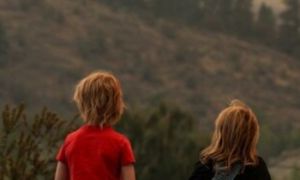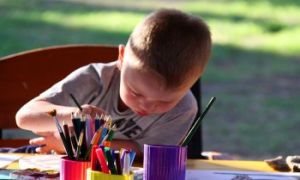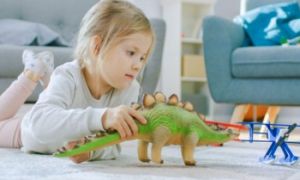To support children achieve learning outcomes from the EYLF Framework Version 2.0, the following list gives educators examples of how to promote children's learning in each individual learning outcome. These can be used when assessing children's learning, critically reflecting on the experiences planned, strategies to implement for each learning outcome and more. It also encourages and promotes each individual outcome throughout the early childhood setting.
Outcome 1: Children Have A Strong Sense Of Identity
Children feel safe, secure and supported
Educators promote this learning for all children when they, for example:
- acknowledge and respond sensitively to children’s cues, signals and home languages
- value and respond sensitively to children’s attempts to initiate interactions and conversations
- support children’s sense of security through consistent and warm nurturing relationships
- give children their full attention, showing interest, understanding and attunement
- design and use routines and rituals to support smooth and effective transitions
- ensure daily schedules, including individualised arrival, departure or sleep rituals that support children’s sense of security
- are attuned to children’s natural daily rhythms to support being and belonging
- learn keywords in children’s home languages and use them when greeting and talking with children
- ensure continuity to bridge the gap between the familiar and the unfamiliar, e.g. feeding and sleeping routines
- build upon culturally valued child-rearing practices and approaches to learning
- provide a culturally safe place where Aboriginal and Torres Strait Islander children and children from culturally diverse backgrounds can share their stories about history and culture
- are emotionally available, listen carefully and support children’s expression of their thoughts and feelings
- recognise children’s feelings of distress, fear or discomfort and understand that these feelings may take some time to resolve
- acknowledge each child’s uniqueness in positive ways
- provide opportunities to invite Aboriginal and Torres Strait Islander educators to provide feedback and reflections on assisting Aboriginal and Torres Strait Islander children to feel safe, secure and supported
- interact and converse with each child to establish mutual trust and respect between the families that attend the early childhood setting
- display both Aboriginal and Torres Strait Islander flags at the setting and discuss their importance for all Australians
- develop inclusive learning approaches that acknowledge different ways of knowing, being and doing
- enable children to see their culture in the environment, e.g. Aboriginal or Torres Strait Islander art from the local region, and cultural events that are significant in the child’s life.
Children develop their emerging autonomy, inter-dependence, resilience and agency
Educators promote this learning for all children when they, for example:
- provide children with strategies to make informed choices about their actions, interactions and behaviours
- promote children’s sense of belonging, connectedness and wellbeing
- maintain high expectations of each child’s capabilities
- share stories with families including Aboriginal and Torres Strait Islander and culturally and linguistically diverse families about their child’s learning success
- mediate and assist children to negotiate their rights in relation to the rights of others
- provide opportunities for children to engage independently with tasks and play
- display delight, encouragement and enthusiasm for children’s attempts
- support children’s efforts, assisting and encouraging as appropriate
- motivate and encourage children to succeed when they are faced with challenges
- share stories of Aboriginal and Torres Strait Islander people who have shown agency and resilience
- provide time and space for children to engage in both individual and collaborative pursuits
- build on the culturally valued learning of individual children’s communities
- share stories that reflect children’s cultural and family diversity
- encourage children to make choices and decisions.
- acknowledge and join in with children’s expressions of pleasure and pride in their efforts and accomplishments
- promote in all children a strong sense of who they are and their connectedness to others – and a shared identity as Australians
- ensure all children experience pride and confidence in their achievements
- describe and share children’s successes with families
- show respect for, and celebrate, diversity, acknowledging the varying approaches of children, families, communities and cultures
- acknowledge and understand that children construct meaning in many different ways
- demonstrate a deep understanding of each child, their family and community contexts in planning for children’s learning, development and wellbeing
- provide children with diverse examples of the many ways identities and culture are recognised and expressed
- build upon culturally and linguistically valued approaches to learning
- build on the funds of knowledge, languages and understandings that children bring
- talk with children in respectful ways about similarities and differences in people
- provide rich and diverse resources that reflect children’s social and cultural worlds
- listen to and learn about children’s understanding of themselves
- actively support the maintenance of home language and culture
- develop authentic children’s understanding of themselves
- provide books and other resources that depict diverse gender roles and identities respectfully
- support sharing of spaces and resources safely and equitably
- acknowledge each child’s family, culture and individual uniqueness in positive ways
- support all children to access science and technology experiences safely regardless of gender, age, culture or ability
- recognise disability as a form of diversity and demonstrate inclusive approaches in their interactions with children
- implement approaches to support gifted and talented children
- provide inclusive indoor and outdoor environments that incorporate reasonable adjustments where there are barriers to participation
- have opportunities to develop knowledge and understanding of Aboriginal and Torres Strait Islander relationships and connections to Country and family including kinships systems
- support children to identify and assess risks in play and learning and to cope with the unexpected.
Children learn to interact in relation to others with care, empathy and respect
Educators promote this learning for all children when they, for example:
- initiate one-to-one interactions with children, particularly with very young children, during daily routines
- pay attention to, appreciate and acknowledge children’s independent efforts to approach and initiate interactions with other children
- organise learning environments in ways that promote small group interactions and play experiences
- facilitate sharing of equipment and turn-taking, being mindful of children’s differing capacities to wait
- model care, empathy and respect for children, colleagues and families
- provide a culturally safe and secure environment for all
- provide secure and predictable environments, relationships and engagement in learning to support children affected by trauma
- build awareness of different emotions by modelling and naming feelings
- support children to learn about and recognise safe and unsafe situations
- model how to respond appropriately to unfairness, challenge stereotypes and discrimination in respectful ways
- explain and provide self-regulation strategies using books and pictures of emotional states
- model explicit communication strategies to support children to initiate interactions and join in play and social experiences in ways that sustain productive relationships with other children
- acknowledge children’s complex relationships and sensitively intervene in ways that promote consideration of alternative perspectives and social inclusion
- provide opportunities for all children to develop knowledge and understanding of Aboriginal and Torres Strait Islander history and culture in the context of their community
- use a range of teaching strategies and multicultural resources to acknowledge and show respect for differences, e.g. multicultural dolls, books and artefacts
- facilitate child-friendly ways for children to express their views and raise their concerns
- enable children to participate in decision-making that affects them.
Outcome 2: Children Are Connected With And Contribute To Their World
Children develop a sense of connectedness to groups and communities and an understanding of their reciprocal rights and responsibilities as active and informed citizens
Educators promote this learning for all children when they, for example:
- promote a sense of community within the early childhood setting
- build connections between the early childhood setting and the local community
- create opportunities for open and authentic partnerships with all families, communities and organisations, including with Aboriginal and Torres Strait Islander people and organisations and those from culturally diverse backgrounds
- provide opportunities for children to investigate ideas, complex concepts and ethical issues that are relevant to their lives and their local communities
- model language that children can use to express ideas, negotiate roles and collaborate to achieve goals
- support and build children’s skills to participate and contribute to group play and projects
- invite grandparents and ‘grand friends’ to assist in planned experiences such as storytelling, and to engage in play
- plan opportunities for children to participate in meaningful ways in group discussions and shared decision-making about rules and expectations
- investigate and explore cultures, traditions and heritages to broaden children’s understanding of the world
- model practices that create a culture of inclusion and social justice within the setting and community
- challenge children to explore the natural and constructed environments
- investigate the dependence between people, animals, plants, lands and waters
- build partnerships with Aboriginal and Torres Strait Islander communities and organisations that are genuine and sustainable
- build children’s awareness of the 7Rs of sustainability: reduce, reuse, recycle, respect, repair, reflect and refuse as part of economic and environmental sustainability
- use digital technologies and the internet with children to explore solutions or assistance to community issues.
Children respond to diversity with respect
Educators promote this learning for all children when they, for example:
- reflect on their own responses to diversity
- plan experiences and provide resources that broaden children’s perspectives and encourage appreciation of diversity, including disability, family diversity, cultural and linguistic diversity
- expose children to different languages and dialects and encourage appreciation of linguistic diversity
- encourage children to listen to others and respect diverse perspectives
- demonstrate positive responses to diversity in their own behaviour and in conversations with children
- engage in interactions with children that promote respect for diversity and value distinctiveness
- ensure representations of diversity authentically reflect local community experience, e.g. displays and resources
- explore the culture, language, heritage, backgrounds and traditions of each child within the context of their family and community
- explore with children their ideas about diversity
- ensure that Aboriginal and Torres Strait Islander resources are genuine and appropriate
- provide experiences connecting children with the community and environment beyond the early childhood setting with appropriate adjustments to ensure the participation by all children
- with additional needs/disability
- use creative forms of expression to explore diversity and emotions
- use digital technologies to find answers to questions and document discoveries.
Children become aware of fairness
Educators promote this learning for all children when they, for example:
- notice and listen carefully to children’s concerns and explore diverse perspectives on issues
of inclusion and exclusion and fair and unfair behaviour - provide materials, texts and resources that are inclusive of gender, ability, ethnicity, culture, language and family diversity
- provide equitable opportunities for children, including Aboriginal and Torres Strait Islander children and children who have diverse capabilities, to contribute positively to their world
- analyse and discuss with children the ways in which texts may construct a limited range of identities and reinforce stereotypes
- draw children’s attention to issues of fairness in the early childhood setting and community
- build cultural partnerships in their environment
- seek guidance from Aboriginal and Torres Strait Islander Elders and community members about local processes and protocols, history and culture
- provide materials, texts and resources that provide opportunities to analyse and challenge unfairness
- provide clear, accessible information for families and communities about the service’s policies including child safety and wellbeing, Code of Conduct, record-keeping practices, and
- complaints and investigation processes.
Children become socially responsible and show respect for the environment
Educators promote this learning for all children when they, for example:
- provide children with access to a range of natural materials in their environment
- model respect, care and appreciation for the natural environment
- find ways of enabling children to care for and learn from the land
- consider the nature of children’s connectedness to the land and demonstrate respect for community protocols
- share information and provide children with access to resources about the environment and the impact of human activities on the environments
- embed social, economic and environmental sustainability in daily routines and practices, e.g. inclusion, sharing of resources and reducing waste
- support children to build relationships with each other based on peace, equality and human rights
- look for examples of interdependence in the environment and discuss the ways the life and health of living things are interconnected
- share information and examples of how the local Aboriginal or Torres Strait Islander people cared for and sustained the land
- visibly and verbally acknowledge the connection of language and culture to Country and Traditional Owners
- provide experiences for children to care for the Country and connect with animals, plants, lands and waterways in the local community
- provide children with access to their local outdoor spaces, e.g. local bush, coast, desert etc
- investigate with children environmental challenges and explore solutions to problems using digital technologies and the internet
- provide opportunities for children to learn about the interconnected dimensions of sustainability, e.g. recycling bottles and donating funds to local charities and community groups.
Outcome 3: Children Have A Strong Sense Of Wellbeing
Children become strong in their social, emotional and mental wellbeing
Educators promote this learning for all children when they, for example:
- show genuine affection, understanding and respect for all children
- are aware and available to provide comfort for children in distress
- support breastfeeding and respond to children’s cues for hunger and satiety or sense of fullness after eating
- listen and respond empathically when children communicate their distress, fears or frustrations
- collaborate with children to document their achievements and share their successes with their families
- ensure that all children experience pride in their attempts and achievements
- promote children’s sense of belonging, connectedness and wellbeing
- challenge and support children to engage in and persevere at tasks and play
- model positive self-talk to support self-regulation during times of stress
- build upon and extend children’s ideas
- maintain high expectations of each child’s capabilities
- value children’s personal decision-making
- welcome children and families sharing aspects of their culture and spiritual lives to create culturally safe environments
- support families’ diverse parenting approaches
- talk with children about their emotions and responses to events with a view to supporting their understanding of emotional regulation and self-control
- acknowledge and affirm children’s efforts and growth
- assist children to develop strategies to foster positive mental wellbeing
- investigate how physical movement, exercise and healthy lifestyles assist children with mental wellbeing
- discuss unsafe situations that would need to be reported to educators and other adults, including signs of children at risk
- promote body safety awareness with children and families
- help children talk about negative emotions or potentially unsafe behaviours
- discuss and model appropriate use of digital technologies and discuss how to keep children safe online with children and families
- update their own learning of digital and cyber safety for children
- are playful and promote a sense of enjoyment
- mediate and assist children to negotiate their rights in relation to the rights of others
- create spaces for children to rest and engage in relaxation in indoor and outdoor spaces
- support the development of friendships and engaging with peers.
Children become strong in their physical learning and mental wellbeing
Educators promote this learning for all children when they, for example:
- plan for and participate in energetic physical activity with children, including dance, drama, fundamental movement skills and games
- draw on diverse family and community experiences and expertise to include familiar games and physical activities in play
- use physically active play and games as opportunities for children to develop friendships and turn-taking skills
- provide well-planned and challenging outdoor environments that encourage risk-taking and risky play experiences
- are aware of and address personal preferences that may unintentionally impact best practice for promoting children’s physical activity and movement skills
- provide a wide range of tools and materials to resource children’s fine and gross motor skills
- provide ample opportunities and resources for gross motor and movement experiences in both indoor and outdoor learning environments
- provide an environment with challenges for the abilities of children
- explore ways of incorporating knowledge of how bodies function and personal safety
- use the dramatic arts and role-play for supporting children’s exploration of feelings and opinions.
Children are aware of and develop strategies to support their own mental and physical health and personal safety
Educators promote this learning for all children when they, for example:
- actively support children to learn hygiene practices
- promote continuity of children’s personal health and hygiene by sharing ownership of routines and schedules with children, families and the community
- discuss health and safety issues with children and involve them in developing guidelines to keep the environment safe for all
- encourage and teach children about personal safety including strategies to support children’s and families awareness of boundaries
- engage children in experiences, conversations and routines that promote healthy lifestyles and good nutrition
- create a safe environment for Aboriginal and Torres Strait Islander children to share their history and culture, songs, language, food, ceremonies and dance, if they choose
- consider the pace of the day within the context of the community
- learn about e-safety for children and embed and model safe digital practices
- discuss aspects of posture, and other health-related age-appropriate digital practices with children
- provide a range of active and restful experiences throughout the day and support children to make appropriate decisions regarding participation
- provide ongoing opportunities for children to express their ideas, feelings and emotions through the creative arts
- encourage all children to share their history and culture, which could include songs, language, food, ceremonies and dance
- create culturally safe and appropriate learning experiences and spaces (e.g. reflect children’s cultures in the setting)
- design indoor and outdoor spaces of calm to support self-soothing
- talk with children about the benefits of sleep, rest and relaxation for the mind and body
- use flexible approaches to sleep and rest, engaging children in decision-making about their own sleep and rest
- assist children with the understanding that feelings can change over time
- read age-appropriate children’s picture books with body autonomy and boundary themes, and offer these to families to read with their children
- communicate to children that it is ok to say no to touch
- listen carefully and take seriously when children talk about things that bother them
- help children understand the concept of consent by modelling or demonstrating asking for and providing consent and providing opportunities for children to practice.
Outcome 4: Children Are Confident And Involved Learners
Children develop a growth mindset and learning dispositions such as curiosity, cooperation, confidence, creativity, commitment, enthusiasm, persistence, imagination and reflexivity
Educators promote this learning for all children when they, for example:
- recognise and value children’s involvement in learning
- provide learning environments that are flexible and open-ended
- respond to children’s displays of learning dispositions by commenting on them and providing encouragement and additional ideas
- model strategies such as positive self-talk to assist children to manage struggles and cope with challenges or setbacks
- provide feedback to children focused on effort and process over outcome or product
- encourage children to engage in both individual and collaborative explorative learning processes
- listen carefully to children’s ideas and discuss with them how these ideas might be developed
- include a growth mindset model in their everyday activities
- find out how to talk to children about how their brains work and how it grows as they learn
- provide opportunities for children to revisit their ideas and extend their thinking
- model inquiry processes, including wonder, curiosity and imagination, try new ideas and take on challenges
- reflect with children on what and how they have learned
- build on the funds of knowledge, languages and understandings that children bring to their early childhood setting
- explore the diversity of cultures and social identities
- critically reflect on personal responses to the cultural diversity that includes Aboriginal and Torres Strait Islander culture
- create responsive learning environments that promote shared sustained thinking.
Children develop a range of learning and thinking skills and processes such as problem-solving, inquiry, experimentation, hypothesising, researching and investigating
Educators promote this learning for all children when they, for example:
- plan learning environments that are flexible, with appropriate levels of challenge where children are encouraged to explore, experiment and take appropriate risks in their learning
- recognise mathematical understandings that children bring to learning and build on these in ways that are relevant to each child
- provide resources for very young children to explore the properties of materials through manipulating, rotating, collecting, transporting and positioning
- provide children with resources that offer challenge, intrigue and surprise, support their investigations and share their enjoyment
- provide experiences that encourage children to investigate and solve problems
- use language to describe (verbalise) back to children their investigations and learning experiences
- talk to children about how the brain works
- encourage children to use language to describe and explain their ideas
- provide opportunities for involvement in experiences that support the investigation of ideas, complex concepts and thinking, reasoning and hypothesising
- help and encourage children to express or make visible their ideas and theories to others
- model mathematical and scientific language, e.g. count out loud and point out patterns
- join in children’s play and model reasoning, predicting and reflecting processes and language
- intentionally scaffold children’s understandings, including a description of strategies for approaching problems
- listen carefully to children’s attempts to hypothesise and expand on their thinking through conversation and questioning
- provide opportunities for Aboriginal and Torres Strait Islander educators to provide feedback and reflect on everyday practices within their setting
- ensure documentation of learning is visible to encourage the revisiting of ideas and concepts
- support children’s extended investigations with flexible schedules to allow for multiple solutions and ways of thinking to be explored
- model the use of digital technologies and media to assist children to investigate and document their findings
- use cooking experiences, as well as sand and water play, to support mathematical and scientific skills such as observation, reasoning and measurement.
Children transfer and adapt what they have learned from one context to another
Educators promote this learning for all children when they, for example:
- provide play opportunities and realistic materials that reflect children’s daily lives
- value signs of children applying their learning in new ways and talk about this with them in ways that grow their understanding
- support children to construct multiple solutions to problems and use different ways of thinking
- draw children’s attention to patterns and relationships in the environment and in their learning
- plan for time and space where children can reflect on their learning and see similarities and connections between existing and new learning
- share and transfer knowledge about children’s learning from one setting to another, by exchanging information with families and with professionals in other settings
- scaffold children’s understanding of how skills and ideas can be transferred to other activities through conversation and questions
- provide opportunities for all educators to participate in acknowledging the Country and how this can be used in different settings
- encourage children to discuss their ideas and understanding
- encourage and enable children to reflect on and assess their learning, including progress and next steps towards their learning goals
- understand that competence is not tied to any particular language, dialect or culture.
Children resource their own learning through connecting with people, places, technologies and natural and processed materials
Educators promote this learning for all children when they, for example:
- provide opportunities and support for children to engage in meaningful relationships that provide positive learning opportunities
- provide sensory and exploratory experiences with a wide variety of open-ended natural and processed materials
- provide experiences that involve children in the broader community and environment beyond the early childhood setting
- think carefully about how children are grouped for play, considering possibilities for peer scaffolding
- select and introduce appropriate tools, technologies and media and provide the skills, knowledge and techniques to enhance children’s learning
- provide opportunities for children to both construct and take apart materials as a strategy for learning
- develop their skills and knowledge with digital technologies and media in their curriculum to use them confidently with children
- provide resources that encourage children to represent their thinking
- create opportunities to discuss with colleagues the diverse ways of embedding Aboriginal and Torres Strait Islander perspectives into everyday practice
- thoughtfully introduce questions and adopt active listening approaches to prompt problem-solving and creative solutions.
Outcome 5: Children Are Effective Communicators
Children interact verbally and non-verbally with others for a range of purposes
Educators promote this learning for all children when they, for example:
- engage in close, confirming interactions with very young children as they use gestures and make sounds to communicate
- are attuned and respond sensitively and appropriately to children’s efforts to communicate
- listen to and acknowledge children’s approximations of words, to support communication and clarify meanings
- value children’s linguistic heritage and with family and community members encourage the use of and acquisition of home languages and Standard Australian English
- value children’s linguistic heritage and with family and community members encourage the use of and acquisition of home languages and Standard Aboriginal English
- encourage children to recount events in their lives
- play games that promote listening and following instructions, e.g. I spy with my little eye
- recognise that children enter early childhood settings have begun to communicate and make sense of their experiences at home and in their communities
- model language and encourage children to express themselves through language in a range of contexts and for a range of purposes
- engage in sustained communication with children about ideas and experiences, and extend their vocabulary
- include real-life resources to promote children’s use of mathematical language
- provide opportunities for Aboriginal and Torres Strait Islander educators to share ideas about best practices when embedding Aboriginal and Torres Strait Islander perspectives into planning and practice
- provide opportunities for children to recognise the different sounds and words of languages other than English
- provide opportunities for visual communication such as signing.
Children engage with a range of texts and gain meaning from these texts
Educators promote this learning for all children when they, for example:
- read and share a range of books and other texts with children
- provide a literacy-enriched environment including display print in home languages and Standard Australian English
- sing and chant rhymes, jingles and songs
- engage children in play with words and sounds
- explore concepts such as rhyme and letters and sounds when sharing texts with children
- incorporate familiar family and community texts and tell stories
- join in children’s play and engage children in conversations about the meanings of images and print
- engage children in discussions about books and other texts that promote consideration of diverse perspectives
- support children to analyse ways in which texts are constructed to present particular views and to sell products
- teach art as a language and how artists can use the elements and principles to construct visual/ musical/dance/media texts
- provide opportunities for children to engage with the familiar and unfamiliar culturally constructed text
- seek Aboriginal and Torres Strait Islander guidance to ensure that the authentic voices of Traditional Owners, Elders and community members are highlighted in planning and practice
- engage in Aboriginal and Torres Strait Islander-led professional development about Aboriginal and Torres Strait Islander ways of learning, e.g. 8 ways and both ways pedagogy.
Children express ideas and make meaning using a range of media
Educators promote this learning for all children when they, for example:
- build on children’s family and community experiences with creative and expressive arts
- provide a range of resources that enable all children to express meaning through the Arts, including visual arts, dance, drama and music
- ask and answer questions during the reading or discussion of books and other texts
- provide resources that encourage children to experiment with images and print
- teach children skills and techniques that will enhance their capacity for self-expression and communication
- join in children’s play and co-construct materials such as signs that extend the play and enhance literacy learning
- respond to children’s images and symbols, talking about the elements, principles, skills and techniques they have used in order to convey meaning
- critically reflect on how they are embedding Aboriginal and Torres Strait Islander perspectives and voices into every part of their planning and their setting
- use a range of questioning strategies appropriate to each child’s capabilities to gain insight into their thinking
- provide Aboriginal and Torres Strait Islander children opportunities to communicate how they are feeling through writing, the Arts, and construction.
Children begin to understand how symbols and pattern systems work
Educators promote this learning for all children when they, for example:
- draw children’s attention to symbols and patterns in their environment and talk about patterns and relationships, including the relationship between letters and sounds
- provide children with access to a wide range of everyday materials that they can use to create patterns and to sort, categorise, order and compare
- engage children in noticing, using and discussing symbol systems, such as, letters, numbers, time, money, musical notation and other symbols children are exposed to in the environment, texts and images
- encourage children to develop their own symbol systems and provide them with opportunities to explore culturally constructed symbol systems including Aboriginal and Torres Strait
- Islander signs and symbols
- respond to children’s signs and symbol systems and identify elements used to convey meaning
- identify concepts of rhyme and predictable sequences when sharing texts with children
- use music to develop children’s understanding of patterns, e.g. clapping names
- incorporate familiar family and community texts as well as those in different languages and dialects
- scribe descriptions of children’s drawings and display results for comment and reflection.
Children use digital technologies and media to access information, investigate ideas and represent their thinking
Educators promote this learning for all children when they, for example:
- acknowledge technologies are a feature of children’s lives and, as such, will be a feature of their imaginative and investigative play
- provide children with access to a range of technologies
- integrate technologies across the curriculum and into children’s multimodal play experiences and projects
- teach skills and techniques and encourage children to use technologies to explore new information and represent their ideas
- encourage collaborative learning about and through technologies between children, and children and educators
- provide opportunities for children to have access to different forms of communication technologies
- research topics and search for information with children
- teach children critical reflection skills and encourage them to evaluate the quality and trustworthiness of information sources
- have opportunities to develop their own knowledge and understanding of appropriate digital technology use and safety with children and families
- assist children to have a basic understanding that the internet is a network that people use to connect and source information.
Further Reading
Free EYLF Version 2.0 Posters and Cheat Sheets - The following provides a list of cheat sheets and free printables based on EYLF Outcomes Version 2.0. These can be used as a reference point for Educators. They can also be used to refer to when documenting and planning.
Reference:
EYLF, Belonging, Being and Becoming Version 2.0, ACECQA


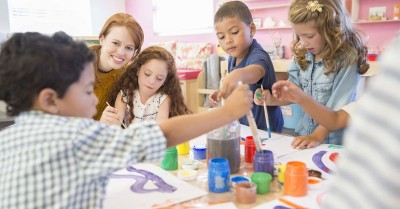
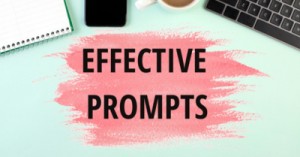


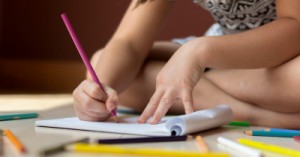
 Here is the list of the EYLF Learning Outcomes that you can use as a guide or reference for your documentation and planning. The EYLF
Here is the list of the EYLF Learning Outcomes that you can use as a guide or reference for your documentation and planning. The EYLF The EYLF is a guide which consists of Principles, Practices and 5 main Learning Outcomes along with each of their sub outcomes, based on identity,
The EYLF is a guide which consists of Principles, Practices and 5 main Learning Outcomes along with each of their sub outcomes, based on identity, This is a guide on How to Write a Learning Story. It provides information on What Is A Learning Story, Writing A Learning Story, Sample
This is a guide on How to Write a Learning Story. It provides information on What Is A Learning Story, Writing A Learning Story, Sample One of the most important types of documentation methods that educators needs to be familiar with are “observations”. Observations are crucial for all early childhood
One of the most important types of documentation methods that educators needs to be familiar with are “observations”. Observations are crucial for all early childhood To support children achieve learning outcomes from the EYLF Framework, the following list gives educators examples of how to promote children's learning in each individual
To support children achieve learning outcomes from the EYLF Framework, the following list gives educators examples of how to promote children's learning in each individual Reflective practice is learning from everyday situations and issues and concerns that arise which form part of our daily routine while working in an early
Reflective practice is learning from everyday situations and issues and concerns that arise which form part of our daily routine while working in an early Within Australia, Programming and Planning is reflected and supported by the Early Years Learning Framework. Educators within early childhood settings, use the EYLF to guide
Within Australia, Programming and Planning is reflected and supported by the Early Years Learning Framework. Educators within early childhood settings, use the EYLF to guide When observing children, it's important that we use a range of different observation methods from running records, learning stories to photographs and work samples. Using
When observing children, it's important that we use a range of different observation methods from running records, learning stories to photographs and work samples. Using This is a guide for educators on what to observe under each sub learning outcome from the EYLF Framework, when a child is engaged in
This is a guide for educators on what to observe under each sub learning outcome from the EYLF Framework, when a child is engaged in The Early Years Learning Framework describes the curriculum as “all the interactions, experiences, activities, routines and events, planned and unplanned, that occur in an environment
The Early Years Learning Framework describes the curriculum as “all the interactions, experiences, activities, routines and events, planned and unplanned, that occur in an environment